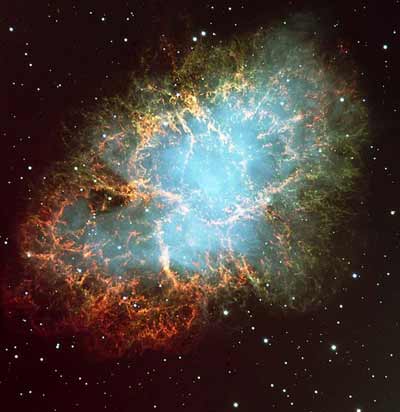Stars What Is A Star? A star is a massive body of plasma in outer space that is currently producing or has produced energy through nuclear fusion. Unlike a planet, from which most light is reflected, a star emits light because of its intense heat. Scientifically, stars are defined as self-gravitating spheres of plasma in hydrostatic equilibrium, which generate their own energy through the process of nuclear fusion. Stellar astronomy is the study of stars.
The energy produced by stars radiates into space as electromagnetic radiation, as a stream of neutrinos from the star's core, and as a stream of particles from the star's outer layers (its stellar wind). The peak frequency of the light depends on the temperature of the outer layers of the star. Besides the emitted visible light, the ultraviolet and infrared components are typically significant. The apparent brightness of a star is measured by its apparent magnitude.
Star Formation & Evolution
 Star formation occurs in molecular clouds, large regions of high density in the interstellar medium (though still less dense than the inside of an earthly vacuum chamber). Star formation begins with gravitational instability inside those clouds, often triggered by shockwaves from supernovae or collision of two galaxies (as in a starburst galaxy). High mass stars powerfully illuminate the clouds from which they formed. One example of such a nebula is the Orion Nebula. Star formation occurs in molecular clouds, large regions of high density in the interstellar medium (though still less dense than the inside of an earthly vacuum chamber). Star formation begins with gravitational instability inside those clouds, often triggered by shockwaves from supernovae or collision of two galaxies (as in a starburst galaxy). High mass stars powerfully illuminate the clouds from which they formed. One example of such a nebula is the Orion Nebula.
Stars spend about 90% of their lifetime fusing hydrogen to produce helium in high-temperature and high-pressure reactions near the core. Such stars are said to be on the main sequence.
Small stars (called red dwarfs) burn their fuel very slowly and last tens to hundreds of billions of years. At the end of their lives, they simply become dimmer and dimmer, fading into black dwarfs. However, since the lifespan of such stars is greater than the current age of the universe (13.6 billion years), no black dwarfs exist yet.
As most stars exhaust their supply of hydrogen, their outer layers expand and cool to form a red giant. In about 5 billion years, when the Sun is a red giant, it will be so large that it will consume both Mercury and Venus. Eventually the core is compressed enough to start helium fusion, and the star heats up and contracts. Larger stars will also fuse heavier elements, all the way to iron, which is the end point of the process. Since iron nuclei are more tightly bound than any heavier nuclei, they cannot be fused to release energy. Likewise, since they are more tightly bound than all lighter nuclei, energy cannot be released by fission. In old, very massive stars, a large core of inert iron will accumulate in the center of the star.
An average-size star will then shed its outer layers as a planetary nebula. The core that remains will be a tiny ball of degenerate matter not massive enough for further fusion to take place, supported only by degeneracy pressure, called a white dwarf. These too will fade into black dwarfs over very long stretches of time.
In larger stars, fusion continues until an iron core accumulates that is too large to be supported by electron degeneracy pressure. This core will suddenly collapse as its electrons are driven into its protons, forming neutrons and neutrinos in a burst of inverse beta decay. The shockwave formed by this sudden collapse causes the rest of the star to explode in a supernova. Supernovae are so bright that they may briefly outshine the star's entire home galaxy. When they occur within the Milky Way, supernovae have historically been observed by naked-eye observers as "new stars" where none existed before. Eventually, most of the matter in a star is blown away by the explosion (forming nebulae such as the Crab Nebula) and what remains will be a neutron star (sometimes a pulsar or X-ray burster) or, in the case of the largest stars, a black hole.
The blown-off outer layers of dying stars include heavy elements which may be recycled during new star formation. These heavy elements allow the formation of rocky planets. The outflow from supernovae and the stellar wind of large stars play an important part in shaping the interstellar medium.
Appearance & Distribution of Stars
All stars except the Sun appear to the human eye as shining points in the nighttime sky that twinkle because of the effect of the Earth's atmosphere. Interferometer telescopes are required in order to produce images of these objects. The Sun is also a star, but it is close enough to Earth to appear as a disk instead, and to provide daylight.
Stars are not spread uniformly across the universe, but are typically grouped into galaxies. A typical galaxy contains hundreds of billions of stars. The majority of stars are gravitationally bound to other stars, forming binary stars. Larger groups called star clusters also exist.
Astronomers estimate that there are at least 70 sextillion (7�1022) stars in the known universe. That is 70 000 000 000 000 000 000 000, or 230 billion times as many as the 300 billion in our own Milky Way.
The nearest star to the Earth, apart from the Sun, is Proxima Centauri, which is 39.9 trillion kilometers, or 4.2 light years away (light from Proxima Centauri takes 4.2 years to reach Earth). Travelling at the orbit speed of the Space Shuttle (5 miles per second -- almost 30,000 kilometers per hour), it would take about 150,000 years to get there. Distances like this are typical inside galactic discs, where the Sun and Earth are located. Stars can be much closer to each other in the centres of galaxies and globular clusters, or much further apart in galactic halos.
Small (dwarf) stars such as the Sun generally have essentially featureless disks with only small starspots. Larger (giant) stars have much bigger, much more obvious starspots, and also exhibit strong stellar limb-darkening (the brightness decreases towards the edge of the stellar disk).
Age & Size of Stars
 Many stars are between 1 billion and 10 billion years old. Some stars may even be close to 13.7 billion years old, which is the observed age of the universe. (See Big Bang theory and stellar evolution.) They range in size from the tiny neutron stars (which are actually dead stars) no bigger than a city, to supergiants like the North Star (Polaris) and Betelgeuse, in the Orion constellation, which have a diameter about 1,000 times larger than the Sun�about 1.6 billion kilometers. However, these have a much lower density than the Sun. Many stars are between 1 billion and 10 billion years old. Some stars may even be close to 13.7 billion years old, which is the observed age of the universe. (See Big Bang theory and stellar evolution.) They range in size from the tiny neutron stars (which are actually dead stars) no bigger than a city, to supergiants like the North Star (Polaris) and Betelgeuse, in the Orion constellation, which have a diameter about 1,000 times larger than the Sun�about 1.6 billion kilometers. However, these have a much lower density than the Sun.
One of the most massive stars known is η Carinae, with 100�150 times as much mass as the Sun. Recent work by Donald Figer, an astronomer at the Space Telescope Science Institute in Baltimore, Maryland, suggests that 150 solar masses is the upper limit of stars in the current era of the universe. He used the Hubble Space Telescope to observe about a thousand stars in the Arches cluster, a massive young star cluster near the core of the Milky Way, and found no stars over that limit despite a statistical expectation that there should be several. The reason for this limit is not precisely known, but the Eddington limit is part of the answer. The very first stars to form after the Big Bang may have been larger, up to 300 solar masses or more, due to the complete absence of elements heavier than lithium in their composition. This generation of supermassive star is long extinct, however, and currently only theoretical.
With a mass only 93 times that of Jupiter, AB Doradus C, a companion to AB Doradus A, is the smallest known star undergoing nuclear fusion in its core. Smaller bodies are brown dwarfs, which occupy a poorly-defined grey area between stars and gas giants. The minimum mass a star can have is estimated to be in the vicinity of 75 Jupiters. Star Classification
There are different classifications of stars ranging from type W, which are very large and bright, to M, which is often just large enough to start ignition of the hydrogen. Some of the more common classifications are O, B, A, F, G, K, M, and can perhaps be more easily remembered using the mnemonic "Oh, Be A Fine Girl, Kiss Me" (variant: change "girl" to "guy"), invented by Annie Jump Cannon (1863-1941). There are many other mnemonics for star classification; the most frequent addition tacks "Right Now, Sweetheart" for the red dwarf sub-types R, N and S. The new types L and T have also been recently appended to the end of the OBAFGKM sequence to classify the coldest low-mass stars and brown dwarfs, prompting such additions as "Lovingly Tonight" to the mnemonic.
Each letter has 10 subclassifications. Our Sun is a G2, which is very near the middle in terms of quantities observed. Most stars fall into the main sequence which is a description of stars based on their absolute magnitude and spectral type. The Sun is taken as the prototypical star (not because it is special in any way, but because it is the closest and most studied star we have), and most characteristics of other stars are usually given in solar units.
For example, the mass of the Sun is
MSun = 1.9891�1030 kg
The masses of other stars can be given in terms of MSun. ** Information provided by Wikipedia, the free online encyclopedia. **
Permission is granted to copy, distribute and/or modify this document
under the terms of the GNU Free Documentation License, Version 1.2
or any later version published by the Free Software Foundation;
with no Invariant Sections, no Front-Cover Texts, and no Back-Cover Texts.
A copy of the license is included in the section entitled "GNU
Free Documentation License". |